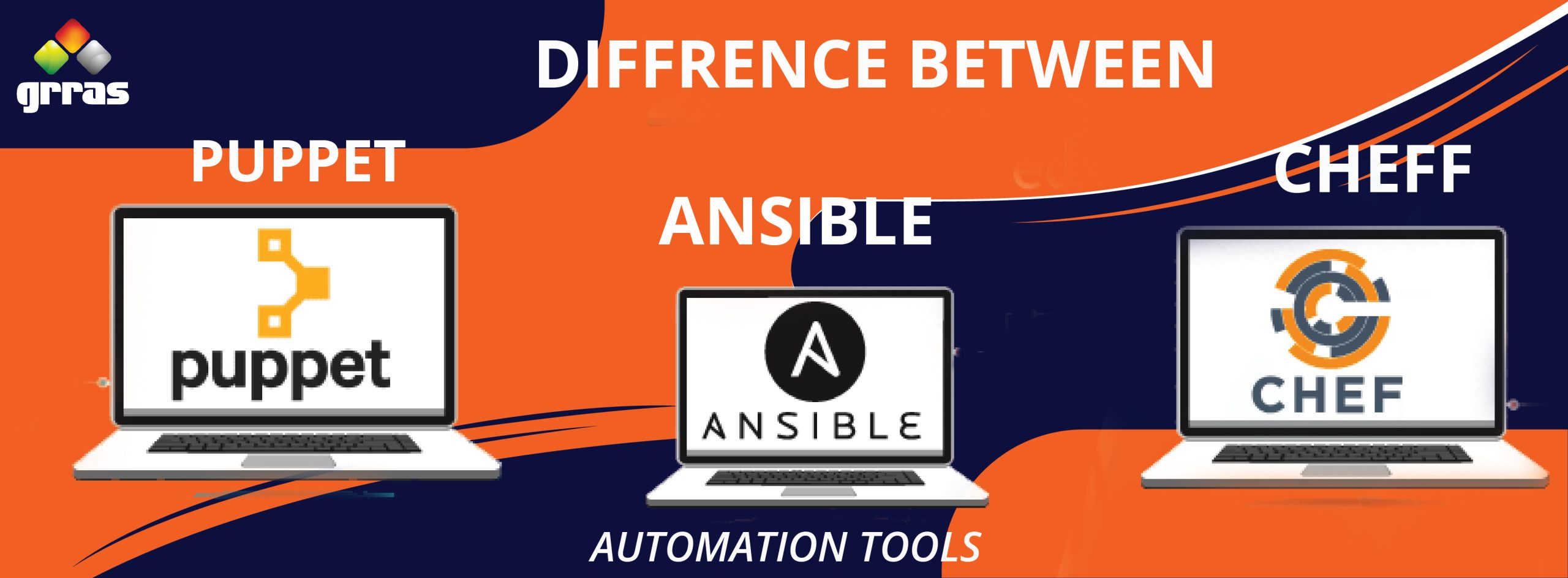DevOps has become an inseparable part of every business organization. For the smooth and viable functioning between the various departments of a company, especially the department of development and the department of operations, DevOps has played a major part. However, DevOps is known as a philosophy rather than a technology. It is mainly dependent on how a DevOps expert carries out the process and makes use of the most appropriate tools for management.
Talking about DevOps tools, there are a lot many out there. There are various kinds of configuration management tools which are included in DevOps certification. These said tools are there with the purpose of deploying, configuring, and managing servers. The most widely used ones are Ansible, Chef, and Puppet Automation tools. However, are you aware with what is the difference between Ansible, Chef, and Puppet Automation Tools?
With this blog, you will get to know the difference between the said major tools as go along stating the pros and cons of each of these. The motive behind the blog is to make you aware of what each tool’s strength and weakness is, which will further help you to decide the best one for your organization, based on the nature of it. Ansible, Chef, and Puppet Automation tools are all commanding enough to have the power to automate intricate and multifaceted multi-tier IT applications, while being stated as pretty simple to use.
We hope this blog on what is difference between Ansible, Chef, and Puppet Automation Tools will throw some light on these tools individually and help you decide on one for your business as per your requirements.
Based on Availability –
When you compare Ansible, Chef, and Puppet on the basis of availability, it is a thing worth noticing that each of these have several servers and are referred to as highly available. Thus, when and if in a situation the main server of your company goes down, its backup will get into action immediately.
Ansible: There is a single active node, also referred to as Primary instance. In case it goes down, it is instantly replaced by secondary instance.
Chef: The Chef server is the primary server, which is instantly taken over by the secondary one when a failure occurs.
Puppet: The Puppet Automation tool is a little different as it has multi-master architecture. When something shoots down the active master, another one takes over without hierarchy.
Based on Ease of Setting Up –
While each of the automation tools mentioned in the blog are pretty easy to set up and get running, this blog is all about the difference between Ansible, Chef, and Puppet Automation Tools, so here is the difference.
Ansible: While master runs on the server machine, the client machine sees no agents running. No special setup is necessary for client machine VM, making it incredibly faster to set up.
Chef: As already established above, a master agent architecture is what Chef supports. On the master machine, Chef Server runs, and on each client machine, Chef Client runs. Adding to this, an extra component known as the workstation is also present, making it a little more complex to set up.
Puppet: Like Chef, Puppet is also based on Master-agent architecture. On the master machine, Puppet Server runs, and on each client machine, Puppet Client runs. To add to this, certification signing between the two is also there, making it not an easy automation tool to set up.
Based on Management –
In order to understand the difference between Ansible, Chef, and Puppet Automation Tools, you must also understand how they work based on management. And for you to comprehend them better based on this point of difference, there is something you need to understand first. Ansible automation tool follows push configuration, while Chef and Puppet automation tools follow pull configuration.
Let us make it clearer. In push configuration, as used in Ansible, all the configurations which are there in the central server are pushed to the nodes. On the contrary, in pull configuration, as used in Chef and Puppet, all the configurations will automatically be pulled from the central server by the slave nodes without any command.
Ansible: One can learn to manage Ansible pretty easily as it uses Yet Another Markup Language or YAML. It is excellent for real time applications.
Chef: In order to manage Chef, one has to be a programmer because the configurations are offered in Ruby DSL.
Puppet: Puppet uses a self-made language known as Puppet DSL, which stands for Domain Specific Language. Hence, making it not a very easy tool to manage. You have to first learn the language in order to manage this automation tool.
Based on Configuration Language –
The configuration language each of the tools use make a lot of difference between Ansible, Chef, and Puppet. All three automation tools which we are talking about use different languages for configuration.
Ansible: Yet Another Markup Language or YAML by Python is used by Ansible. This language is not a very difficult one to learn and also, it is administrator oriented.
Chef: Ruby DSL or Domain Specific Language is used by Chef. This language is developer oriented and has a steep learning curve.
Puppet: The language used by Puppet is its own known as Puppet DSL or Domain Specific Language. It is system administrator oriented and is a little difficult to learn.
Based on Interoperability –
Let us take each of the automation tools into consideration to understand more about the interoperability.
Ansible: While Ansible server has definitely to on Unix/Linux machine, it also supports windows machines.
Chef: While the Workstation and Chef Client can be on windows, Chef Server only works on Unix/Linux.
Puppet: While Puppet agent can also work on windows, Puppet Master only works on Unix/Linux.
Based on Scalability –
When it comes to what is the difference between Ansible, Chef, and Puppet automation tools, there is very few on the basis of Scalability. Each of the three tools discussed in the blog are extremely highly scalable. These tools can easily handle large infrastructure.
Conclusion
We hope this blog on ‘what is the difference between Ansible, Chef, and Puppet Automation tools’ will help you get to the conclusion as to which automation tool will be the best for your organization. As we said above, DevOps is person oriented and a large portion of its affect depends on how the expert is handling things. However, it is also important and highly dependent on the tools they use to manage the bridge between development and operation department.
These automation tools make it easier for the DevOps expert to do their task efficiently and effectively. Whether you are an expert or the head of an organization, understanding the main tools for DevOps and knowing which one will give you the best results is important.






